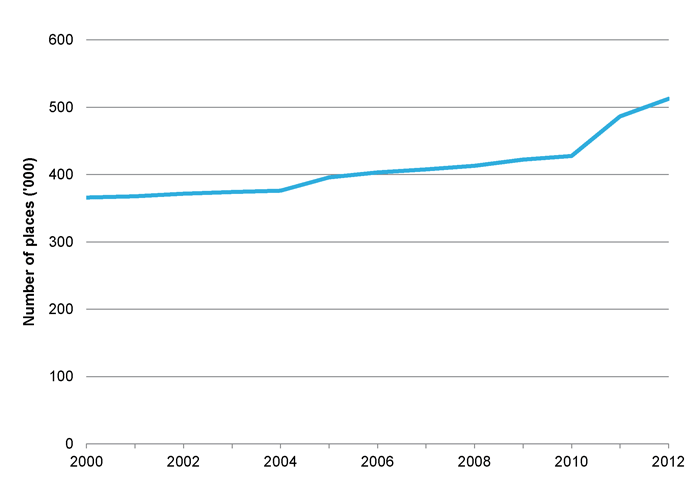Dr Coral Dow, Social Policy
Key issue
The Labor Government implemented major reforms to higher education through a student demand-driven system and associated funding reforms. The reforms resulted in increased uptake of Commonwealth-supported places and increased Commonwealth expenditure. The 44th Parliament will be faced with decisions regarding the sustainability of the system. |
The student demand driven system: enrolment growth
In response to the 2008 Review of Australia’s higher education system, chaired by Denise Bradley, the Labor Government implemented major reforms to higher education.
The major reform was to ‘uncap’ the allocation of university places through a demand-driven system for domestic students. Other reforms included a revised indexation rate of university funding, increased funding aimed at improving the participation rate of low Socio Economic Status (SES) students and increasing the eligibility to student income support.
The partial uncapping of places in 2010, and the full deregulation in 2012, resulted in a strong take up of university places (see Figure 1) and revised budget forward estimates of the numbers of places. In 2009, estimates of 458,000 undergraduate places for 2012 were increased to 512,600; this is estimated to grow to 589,000 places in 2016.
Figure 1: Undergraduate university places, 2000 to 2012
Source: Portfolio Budget Statements
Analysis by the Grattan Institute shows most additional demand has been in the disciplines of health, science and engineering.
This appears to indicate that the Labor Government’s target for 40% of 25 to 34 year olds to hold a degree by the year 2025 will be met. In 2012 the proportion of this age group with a degree was 37%, partly due to the intake of skilled migrants.
The Labor Government’s other target, which was that by 2020, people from low SES backgrounds represent 20% of higher education enrolments, might also be met. In 2012, low SES commencing students increased by 9.1% compared to 2011. However, as a share of students the increase is slower: from 16.6% in 2011 to 16.9% in 2012.
The student demand driven system: expenditure growth
Increased uptake has been accompanied by an increase in expenditure from the Commonwealth Grants Scheme (CGS), the primary source of funding for places. In 2009–10 CGS spending was $4.56 billion and is estimated to increase to $7.19 billion in 2016–17. Such growth has raised concerns about the sustainability of the uncapped system in a period of budget restraints.
Demand may level off as the initial uptake from years of unmet demand falls, and demographic factors may also contribute. However, economic factors, such as the decline in the mining boom, are likely to increase demand. This is because potential students who have declined university places in preference to high-paid employment may return to higher education.
There is widespread support from stakeholders for the uncapped system, but a number of options have been proposed to contain the costs or to slow demand. The Labor Government announced cuts to higher education in April 2013. The proposed cuts were not legislated before the 43rd Parliament was dissolved, but remain in the budget forecast.
Some of the proposed savings were not direct cuts to the sector but a shifting of the burden to students through the removal of a 10% up-front payment Higher Education Loan Program (HELP) discount and the conversion of youth allowance start-up scholarships to HELP loans.
Student contributions
A more direct cost shift would be an increase to the student contribution.
Student places are funded by a combined Commonwealth government contribution and a student contribution. The student contribution varies across a range of broad disciplines and can be deferred as a HELP loan. Increasing the student contribution while maintaining the Government contribution will not reduce Government expenditure, but it would increase the overall amount for each place and avoid a direct cut to the sector.
Government savings could be made by increasing student contributions and also decreasing government contributions: the funding per place to providers stays the same, but the cost is met by students.
Student contribution amounts are set by the Government, but some universities have argued for partial deregulation of student fees. In a submission to the Base Funding Review, the University of Melbourne recommended, for example, that ‘higher education providers be permitted to set maximum student fees of up to 30% more than the base funding rates’.
Full deregulation of fees would see the return of the Howard Government’s policy allowing universities to enrol full fee-paying domestic students and generate income for high demand universities and courses. Such a policy would require modification of the demand-driven system—capping certain places or courses and allowing the unmet demand to be filled by full-fee places.
Students are able to defer payments of their student contributions (including full-fee places) through HELP. Any decision to increase student contributions will need to consider the increased HELP debt and an increase in debt considered unlikely to be repaid, which at present is 17% of HELP debt.
In the 2013–14 Budget, the Government estimated the total HELP debt at $26.2 billion in 2013–14 and that it would grow to $42.1 billion by 2016–17.
Any increase in student contributions may have the effect of slowing demand. Since loans were introduced in 1989 analysis has shown that in general, they do not deter students. However, some studies have concluded that increases deter some groups of students, such as low SES and regional students, those that the uncapped system is in fact trying to attract.
The 44th Parliament will need to weigh up the advantages, both to the individual and to society, when judging the appropriate levels of growth and investment in the higher education sector.
Further reading
Universities Australia, Universities Australia pre-Budget submission 2013–14, Canberra, January 2013.
A Norton, Keep the caps off! Student access and choice in higher education, Grattan Institute, Melbourne, 2013.
For copyright reasons some linked items are only available to members of Parliament.
© Commonwealth of Australia